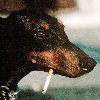HOME | DD
 vcubestudios — TMHOTW: Exceptional Mammals
vcubestudios — TMHOTW: Exceptional Mammals

Published: 2017-11-02 23:47:14 +0000 UTC; Views: 40345; Favourites: 522; Downloads: 67
Redirect to original
Description
These large generalist herbivores are a sample of the many species of mammals that can effectively compete with the herbivorous dinosaurs in Palkragar outside of the grasslands of the Ino Platue, what we call the Exceptional Mammals. Depicted here are the following creatures, 3 of which were created by our friend Lediblock2 whose contribution deserved some wider recognition.Going from left to right...
Rhinopotamus
Alcetherium maximus (Greatest moose beast)
Despite its name, this huge creature is not related to deer at all - it is actually a brontothere, one of the last ones alive. Some smaller forms and a couple of larger species managed to get into Therobis during the Eocene and did fairly well for themselves, but like most of the dinosaurs of that heart, their populations were decimated by the arrival of grass. By the time that a breach opened between Palkragar and Therobis, the brontotheres were just barely hanging on by a couple of species, but Palkragar and its softer vegetation provided a haven for them, allowing them to diversify once again. Nowadays, a fair number of brontotheres exist in Palkragar, and Alcetherium, the rhinopotamus, is one of the largest out of them all. Growing to over nine feet tall at the shoulder and weighing in at roughly 13,000 lbs, this immense dark brown creature is much more massively built than its fossilized relatives, with considerably longer, more pillar-like legs for wading through the water and slightly splayed toes for better distributing its weight across the soft ground of its habitat. Its forequarters sport heightened vertebrae above the shoulder blades, forming supports for a bison-like hump of muscle and fat. But the animal’s most unique feature lies in the skull and jaws. Unlike the more famous Megacerops and Embolotherium, Alcetherium has no horns - it is descended from a more basal branch that lacked horns at all. In fact, the shape of its head is more like that of a gomphothere than anything else - the jaws are elongated, with batteries of long, low open-rooted molars for grinding up waterborne vegetation, as well as a pair of large heavy tusk-like fangs on the upper and lower jaws derived from the incisors, normally kept hidden by the lips when the mouth is closed.
Solitary animals, the rhinopotamus feeds upon the ample vegetation of Hallow Island’s marshes and the Itzune Delta. Its teeth are covered in unusually thick sheathes of enamel for an animal of its size, allowing it to simply tear through rough vegetation, and an enlarged hind gut allows it to digest even fairly toxic plants - the calves often eat their mother’s feces in order to attain the proper gut flora to do this.
Much like moose, these huge brontotheres are quite dangerous animals, often chasing down animals that get too close to their young and trampling them to death like a rhino mixed with an elephant; their fangs are also capable of being used for a very dangerous bite. Very few animals will try to hunt Alcetherium as a result, although their calves, which take up to five years to mature, are a different story, frequently being hunted by both aquatic and terrestrial creatures.
Timber sloth
Gigantonyx imperator (Giant emperor claw)
Ground sloths have done fairly well for themselves in Palkragar, so much so that in some cases, they have actually edged out chalicotheres in several places. Browsers by nature but able to stomach most plant life, they were easily able to adapt to Palkragar’s vegetation, and their immense claws, great size and strength, and chainmail-like coats of osteoderms provided ample protection against predators. One of the largest species to be found within Palkragar is the timber sloth (Gigantonyx imperator), a titanic native to the forests that surround the Tsuni Prairie that exceeds even the surface world's Megatherium in sheer size, occasionally venturing out into the plains to graze upon fresh fern shoots.
Standing at a massive 23 feet tall when rearing up on its hind legs and often exceeding six tons in weight, the timber sloth is one of the largest ground sloths to ever exist - it has to be in order to stand a chance against the various predatory dinosaurs that it shares the heart with, as well as to reach the higher-up plant life of its habitat. In order to support its tremendous size, its body has gone through considerable physiological changes: the claws on its feet are blunt and hoof-like, allowing the animal to walk in a digitigrade stance like other mammals rather than on the sides of its feet like other ground sloths in the fossil record, a stand that better supports its immense weight. It also sports callus-like pads of thick hardened skin on its knuckles; when moving on all fours, it walks on these knuckle pads, providing it with a better grip as it walks. The tail is also wider and thicker, used as a support for the sloth when it rears up on its hind legs, and the rich golden brown fur is much thinner than its ancestors', a necessity to keep the titanic animal cool in the warm environment of the heart.
Solitary by nature, timber sloths, like their ancestors, are primarily browsers, reaching up with their long powerful arms and pulling down high-up greenery, but they are fully capable of feeding upon lower-growing plants and roughage, uprooting shrubs and digging up roots with ease. The gigantic sloths are also not unwilling to feed on meat from time to time, ripping open trees to feed on the grubs under the bark or even chasing small predators away from their kills.
Timber sloth males are a bit bigger than the females, and battle one another fiercely over the right to mate with a female, charging at one another and slashing with their claws, backhanding one another, and even locking arms and wrestling until one drops from either death or exhaustion, with the winner earning the right to mate. Young are born one at a time after an 11-month pregnancy and are cared for by the mother until they reach maturity at about 15 years old; they are quite vulnerable to predation at this stage of their lives, as the osteoderms that protect them during adulthood have yet to fully harden. However, going after a timber sloth cub is an extremely dangerous task: these megafauna are already strong enough to go toe to toe with fully-grown theropod dinosaurs and come out victorious, and they are even more ferocious fighters when defending their young. During the Palkragarian War, several of these sloths were captured and used as war beasts, where they proved incredibly useful in smashing through enemy lines and wading through ranks of infantry. However, their massive food requirements and relatively slow speed resulted in the animals having limited use.
Pronga
Dromaeocervus acroceras (Sharp-horned running-deer)
In world hearts, things often are not as they appear, and a prime example of this is the pronga - despite its scientific name, it is not a deer at all, but a surviving antilocaprid, a lineage that's only represented by the pronghorn up on the surface. However, despite looking like a deer, this graceful herd-dweller lives more like an antelope, moving in large herds across the Tsuni Prairie and grazing upon whatever it can find.
Roughly the size of a white-tailed deer, the pronga is a quite elegant-looking animal, with long lean legs and a beautiful tawny brown-and-gold pelt. The horns, as the name suggests, sport prongs like those on a deer's antlers, and stick directly up into the air like leafless trees. Both genders have these antler-horns, but they are considerably larger and more elaborate in males, rivaling the surface world's mule deer in how large their rack can get.
Moving in herds of up to 250 animals, pronga are among the most common herbivores of the prairie, and live in much the same way as their ancestors did save for feeding on ferns - adapted for the surface world's tougher grasses as their ancestors were, the generally-much softer vegetation of Palkragar posed quite the challenge at first, but necessity is the mother of invention, and with very little else available, the ancestors of the pronga, as well as the other antilocaprids of the heart, managed to cope, their teeth adapting the ferns that carpet the ground, although some species do subsist on grass where it grows in the heart.
While their horns can be used in self-defense in times of extreme duress (They're mainly used in intraspecific battles, particularly by the males), pronga usually flee in response to predators; while they are nowhere near as fast as their surface-world cousins, they can still move with high speeds at nearly 35 mph, zigzagging to better confound predators similarly to impala. However, despite this, they are still a popular prey item of the prairie's various predators, chiefly wolfhawks and Kiro hunters. Reproduction is largely similar to surface pronghorns, with males mating with small groups of females to father one or two fawns at a time; said fawns are a highly-sought after meal for most local carnivores.
American Mastodon
Mammut Americanus (American Breast Tooth)
Palkragar had a minor exodus event about 56,000 years ago, allowing large animals from the Pleistocene to enter the heart. Today, most of them can only be found on the Ino Platue in the south-eastern corner. Yet out of all of them, one giant mammal has seen some success in Palkragar. That being the American Mastodon. The reasons for this were a bit hazy at first, but as time went on the answers became quite clear. Firstly, these animals are very adaptable. Mastodons could once be found all over North America from Alaska to Mexico. So they had no trouble adapting to the subtropical conditions in much of Palkragar. Second, their diet is different. Grass only grows on mass on the Ino Platue. That's why creatures like mammoths and bison can only be found there. The rest of Palkragar's plains are covered in ferns, mosses, and wild flowers. The kind of plants mastodons love. Not to mention the abundance of forests ensure these browsers are well fed. But the biggest reason for their success is due to their docile nature which has led them to be domesticated by the Unchaka People. These animals are bred for labor, transportation, wool and many other commodities.
---
Please Support My Work:
Buy Some Cool Merch: fineartamerica.com/profiles/jo…
Donations Help Too: www.paypal.com/donate/?token=l…
I Take Commissions!
vcubestudios.deviantart.com/jo…
Follow me to these wonderous places!
Youtube: www.youtube.com/channel/UCvViO…
DeviantArt: vcubestudios.deviantart.com/
Minds: www.minds.com/vcubestudios
Vidme: vid.me/VCubestudios
Tumblr: josepharrenart.tumblr.com/
Related content
Comments: 9

👍: 0 ⏩: 0

👍: 0 ⏩: 0

👍: 0 ⏩: 0

That timber sloth really seems to like that ancient elephant
👍: 3 ⏩: 0






















